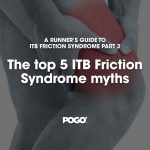Part 1-Why ITB ‘Friction’ Syndrome is not due to ‘friction’
A runner’s guide to the rehabilitation of ITB ‘Friction’ Syndrome
Part 1 – Why ITB ‘Friction’ Syndrome is not due to ‘friction’
Iliotibial band (ITB) friction syndrome is a common running injury. The term iliotibial band syndrome is also often referred to as ‘ITB friction syndrome’. For the purposes of this article we will refer to it as ITB friction syndrome. ITB friction syndrome makes up 12 per cent of all running-related overuse injuries (1). It is the most common running injury of the lateral knee (2).
Over my 11 years in clinical practice I have consulted runners of all abilities, and all manner of running backgrounds who have suffered from ITB friction syndrome. I have also personally experienced a short lived (thankfully) stint many years ago while preparing for a marathon.
The anatomy of the ITB
The iliotibial band (ITB) spans the outside of the thigh running from the iliac crest down the outside of the thigh to insert on the outside of the tibia (Gerdy’s tubercle). It is important to note that the ITB is not a ‘muscle’ per se. Rather anatomically it is a thick band of fascia which I often in practice liken to be a thick ‘rubber band’, made up of layer on layer of fascia (connective tissue). Because of its fibrous nature despite popular opinion it is not possible to stretch the ITB itself. It is an all too common belief amongst runners that a runner suffering from ITB friction syndrome can stretch their ITB in order to resolve the injury (more on this later).
Proximally (near the hip) the ITB splits into superficial and deep layers, with the superficial layer enclosing the tensor fascia latae (TFL) muscle. Much of the gluteus maximus tendon also intertwines with the fibres of the proximal ITB tract. The ITB has fascial connections with many other muscles of the lower leg , including: the biceps femoris (outside hamstring), and the vastus lateralis (outside quadricep).
See the anatomy of the ITB below:



It may be that different subtypes of ITB friction syndrome exist. One that involves irritation of a lateral synovial recess (be it a cyst or bursa), and a second type emanating from compression by the ITB band of the connective tissues that underlie the portion of the band between the lateral epicondyle and the knee joint line.
There appears to be no evidence to support the notion that changes in the ITB band itself take place.
With the ITB crossing both the knee and hip joint it has a role in stabilising both the hip and the knee joints.
With the ITB crossing both the knee and hip joint it has a role in stabilising both the hip and the knee joints. #performbetter @pogophysio Share on XWhat is ITB friction Syndrome?
Pain typically develops on the outside of the thigh (femur) just above and to the outside of the knee joint.

Common belief is that as the knee straightens and bends through the running cycle, the iliotibial band ‘rubs and rolls over’ the outside of the thigh bone (femoral lateral epicondyle) resulting in irritation of the tissues and therefore the runner experiencing pain.
Why ITB Syndrome is not due to ‘friction’
A 2006 study (3) looked microscopically at the local anatomy of 15 cadavers. In the same study MRI imaging was completed for 6 asymptomatic volunteers, and 2 athletes with acute ITB friction syndrome symptoms. In all cadavers the ITB was anchored to the distal femur by fibrous strands associated with a layer of richly innervated and vascularised fat. In no cadaver, volunteer, or patient was a bursa at the typical site of ITB friction syndrome seen. This finding was in opposition to the commonly held belief that there exists an ITB bursa, that is as many believe the structural pain driver of ITB friction syndrome.
The MRI scans showed that the ITB was compressed against the femoral condyle at 30 degrees of knee flexion (bend), as a result of tibial (shin) internal rotation during the stance phase of the running gait cycle. However on full knee extension the ITB moved laterally, not forwards as many would believe. The authors of the study concluded that ITB overuse injuries are more likely associated with fat compression underneath the ITB tract, rather than with repetitive friction as the knee flexes and extends.
The study’s confirmed findings and our interpretation of them are as follows:
- MRI signal changes were present on the 2 patients with acute ITB symptoms in the area of the richly innervated fat-deep to the ITB. This richly innervated area of fat deep to the ITB is the likely pain generator for ITB friction syndrome.
- The ITB is prevented from ‘rolling’ over the epicondyle due to its femoral anchorage and also because it is part of the tensor fascia latae.
Therefore ITB friction syndrome is not really due to forwards and backwards ‘rubbing’ or ‘friction’ as per common dogma amongst runners and medical practitioners alike.
Rather a more accurate description for this injury may be ITB compression syndrome! For the purpose of accuracy I will during the remainder of this article refer to this condition as ITB syndrome.
My own ITB friction syndrome experience
The thing that sticks in my mind from my personal experience of suffering from ITB friction syndrome was how ‘sharp’ the pain around the outside of my knee actually was. I recall running some gentle undulating hills and feeling a sharp ‘stabbing’ pain on the outside of my knee. See the image below:

As a physio when I experienced this sharp pain on the outside of my knee, my immediate thought was ‘not a lateral meniscus injury’. No runner wants to incur a meniscal injury to their knee-be it the lateral or the more commonly injured medial meniscus. The challenge with meniscus injuries being the often times substantial time frames required for rehabilitation.
On self testing my knee I quickly realised that I was experiencing an episode of ITB friction syndrome (I cleared the lateral menisucs-could sit fully on my heels, and I was experiencing no night time pain-generally this is a good quick guide). While it was a relief realising I had ITB friction syndrome pain and not lateral meniscus pain I needed to act quickly to get on top of it as I was inside the final 10 weeks of preparation for the Gold Coast Airport Marathon.
Fortunately I was able to rehabilitate myself inside a two week window, and continue on with my normal marathon training. I will share some of the exercises I performed and insights I used to rehabilitate my own ITB syndrome in this post.
In the next post in this series we will look at the best ways to rehabilitate ITB friction syndrome I believe it is prudent to first debunk three common and popular myths about the ITB, and the management and treatment of ITB syndrome.
Physio With a Finish Line™,

Brad Beer (APAM)
Physiotherapist (APAM)
Author ‘You CAN Run Pain Free!’
Founder POGO Physio
Host The Physical Performance Show
Featured in the Top 50 Physical Therapy Blog
References
- Fredericson M, Wolf C (2005) Iliotibial band syndrome in runners: innovations in treatment. Sports Med 35, 451–459
- Lavine R. Iliotibial band friction syndrome. Current Reviews in Musculoskeletal Medicine. 2010;3(1-4):18-22. doi:10.1007/s12178-010-9061-8.
- Fairclough, J., Hayashi, K., Toumi, H., Lyons, K., Bydder, G., Phillips, N., Best, T. M. and Benjamin, M. (2006), The functional anatomy of the iliotibial band during flexion and extension of the knee: implications for understanding iliotibial band syndrome. Journal of Anatomy, 208: 309–316. doi:10.1111/j.1469-7580.2006.00531.x http://onlinelibrary.wiley.com/doi/10.1111/j.1469-7580.2006.00531.x/full









Hi! I was looking for the exercises you mentioned you would share on this post for the ITB syndrome! Have you mentioned it anywhere?? Could not find it.
Hi Terisha,
Yes that blog post will go live very soon! Stay tuned 😉
Regards Brad Beer
Thanks. Hope to read it soon.